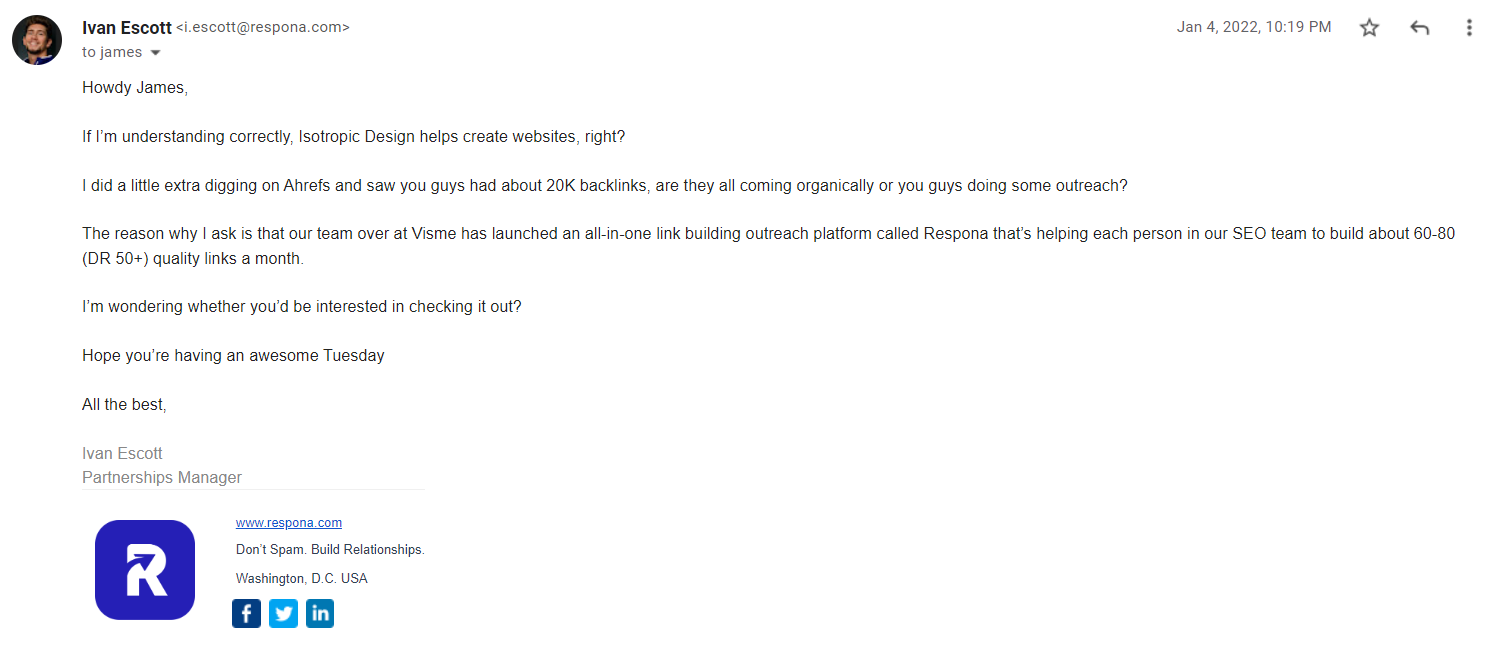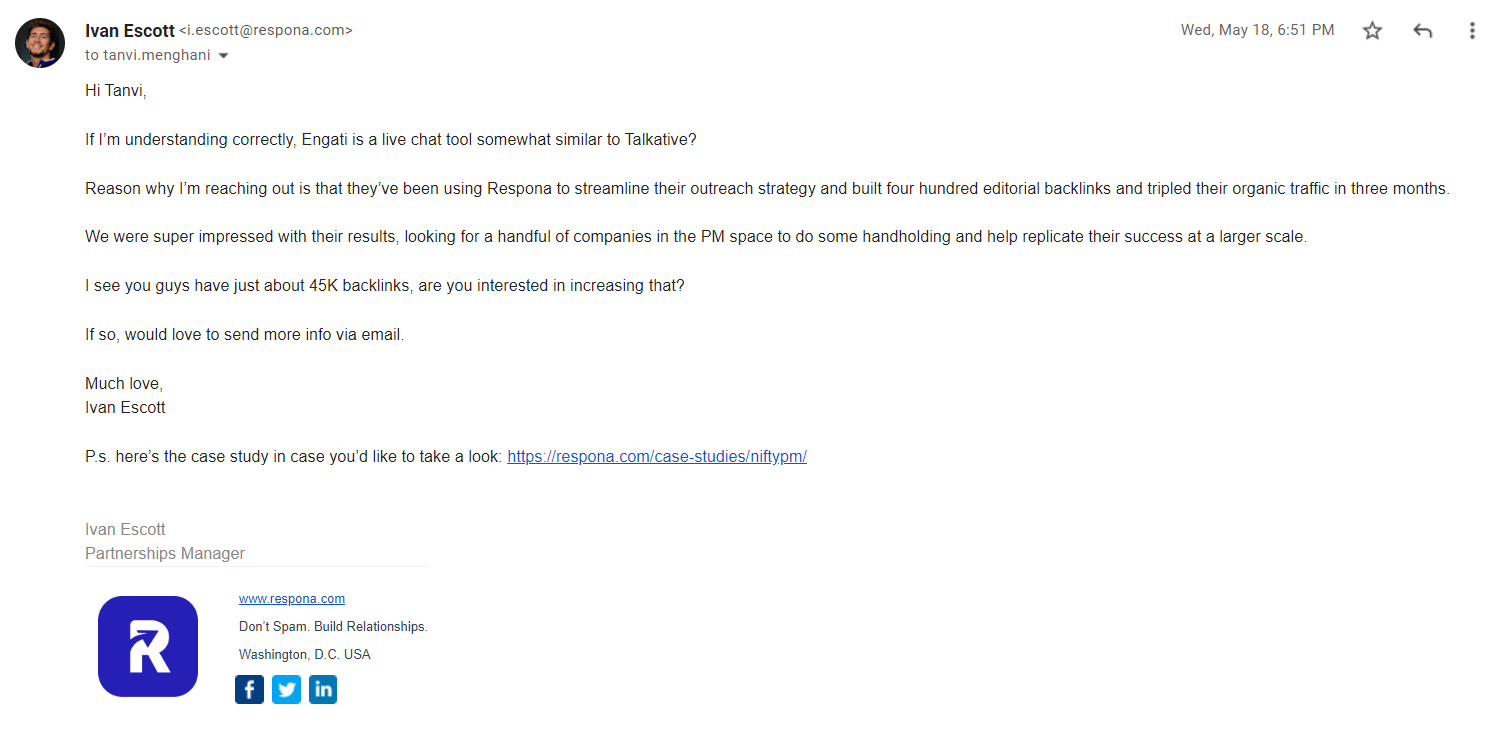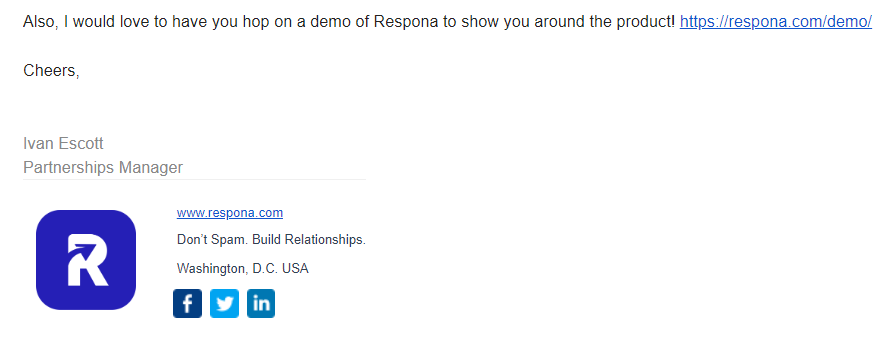While sales emails may look like an ancient practice to the average consumer, they’re still commonplace in the world of B2B.
It is true that your average sales pitch email can make quite a few eyes roll, but that doesn’t mean that the practice as a whole is dead.
In fact, emailing your sales pitches is one of the least expensive ways to develop your business, and, when done correctly, has an incredible return on investment.
The keyword here is “done correctly”. In this article, we’ll be taking a look at:
- The individual elements of a successful sales pitch
- Best practices to convert prospects into customers
- Templates to help you get started
Without further ado, let’s get started!
Link building cheat sheet
Nail the Subject Line
The average maximum length for a subject line (before it is cut off) is only 60 characters on computers.
On mobile, that number is even smaller – only 41 characters.
This means that you only have 6-8 words to capture the attention of your prospect. That is really not a lot, and perhaps one of the main reasons why so many sales professionals struggle with creating cold email subject lines that really drive opens.
However, there are several qualities that make a sales pitch email subject line good, and in this section, we’ll take a look at each one.
Short and sweet
As we just mentioned, you only get 6-8 words on average before your email subject line gets truncated by the email provider.
You can, of course, make your subject line longer than that, but shorter subject lines that aren’t cut off halfway through tend to perform better, and leave a better impression on your potential customer.
Personalized
One of the main reasons why emails get flagged as spam is because the recipient sees that an email was part of marketing automation and very little actual effort went into it.
Personalization is the solution to this problem.
Respona offers variables like {first_name} and {organization} that automatically populate for every prospect in your campaign, but mentioning their name is the very bare minimum you can do when it comes to personalization.
A perfectly personalized email directly addresses a very real pain point that your prospect has (but might not be aware of yet).
However, given the character limit, the name of your prospect or their organization is a good place to start, and, according to Campaign Monitor, can generate 20% more revenue than un-personalized subject lines.
Another tip to make your emails feel more personal is by using an email account with your name rather than your generic “[email protected]” or similar address.
Piques their interest
Making an effective sales pitch subject line interesting is easier said than done, but if you know something that your prospect actually cares about, not only can it get them to open your email, but even prioritize it over any other pitches they have in their inbox.
Some ideas for interesting subject lines might be:
- Asking them for help with something
- A recent finding or statistic from their industry
- A question about something specific within their company
So make sure to conduct research on your prospects – it makes it a lot easier to come up with ideas for your sales pitches.
Valuable
The value proposition is arguably the most important part of any cold outreach email – not only a winning sales pitch.
If you’re able to formulate it in a short enough way so that it fits in your subject line, you might start seeing increased open and reply rates.
Some ideas for providing value in your subject lines are:
- Current promotions and deals you offer
- A product that you know your prospect was looking for
- Exactly how your product/service can help your prospect reach their goals
Creates a sense of urgency (without clickbait)
Do you know a single person whose favorite part of the day is going through emails? Me neither.
Usually, checking emails is done as quickly as possible. Sometimes, people simply don’t have enough time to actually go through every single email they receive.
So, they might leave unread emails for later.
But the reality is that a lot of people you are pitching receive dozens if not hundreds of emails every day. So, if your email was left “for later”, it’s probably never getting opened.
You can create a sense of urgency by mentioning a limited-time deal, offering some sort of bonus incentive, or creating scarcity (even if your product isn’t actually running out).
This can give your prospect a nudge to at least open your email and see what the fuss is about.
However, it’s best to use this strategy sparingly and not rely on it for all of your cold email sales campaigns.
Here are two examples of our own successful sales pitch subject lines:

This pitch example mentions the name of one of our prospect’s competitors. This immediately grabs their attention and piques their interest as to what might be inside the email.

This one is simple yet pretty effective – people are generally interested whenever someone wants to ask them a question about their own business.
Don’t Introduce Yourself
Many cold emails start with the generic “Hello, I’m {name} from {company}. Too many, in fact.
And while it is common courtesy to introduce yourself in other communications, it might actually work against you in an otherwise good sales pitch email.
How?
It can turn your sales pitch into a “me first” email, where you end up only talking about your company, product, or service, making it look generic and uninteresting at best, spammy at worst.
So how should you start your cold email sales pitch?
The whole point of a sales pitch is to capture your prospects’ attention and address their pain point in a way that will leave them wanting to find out more about your product or service.
So, there is your answer.
Start With the Pain Point
If you took a look at our own sales pitch example below, you will notice that they start by immediately addressing the pain point.
More specifically, the way those businesses use link building to generate more organic traffic for their pages.

In your niche, the exact pain point will, of course, be different, but the general formula to follow for the first part consists of three parts:
- Start with the exact problem (even if they’re not yet aware of it)
- Personalize your pitch to their exact situation
- Explain what are the consequences of not addressing that particular problem and what are the benefits you offer
In our own sales outreach, the typical pain point of our potential buyer is them having a low number of backlinks pointing to their website, or their competitors using our platform to generate backlinks at scale while they don’t.
Our go-to personalization is the prospect’s exact number of backlinks, which is data that we pull from Ahrefs.
The consequence of not using Respona to generate links is their content not getting the traffic it deserves or good rankings in search engine results pages.
And the benefit is a greatly sped-up link-building process, making it easier to quickly generate high-quality backlinks than without Respona.
Provide Social Proof
Sales professionals have long used social proof as a means of convincing potential customers to buy their products.
In its most basic form, social proof is the idea that people are more likely to buy a product if they know that other people have already bought it.
This is because people tend to feel more comfortable buying products that have already been vetted by other consumers.
There are a number of ways to provide social proof in your sales pitches. One of the most common is to simply mention that your product is popular. You can do this by citing sales figures or customer testimonials.

Case studies and exact statistics work especially well.
Another way to provide social proof is to offer a money-back guarantee. This shows potential customers that you are confident in your product and that you are willing to stand behind it.
Ultimately, the best way to provide social proof is to let potential customers try your product for themselves.
This could be in the form of a free trial or a discount for first-time buyers. By letting potential customers experience your product firsthand, you can give them the confidence they need to make a purchase.
Include a Call-To-Action
A call to action (CTA) is a request for your audience to take a specific action. A CTA could be something like “Sign up for our newsletter” or “Buy our new product.”
The purpose of a CTA is to guide your prospect toward the next step of your sales process. For example, if you’re selling a product, you want your audience to buy it. If you’re promoting a new service, you want your audience to sign up for it.

A CTA should be clear and concise. It should be easy for your audience to understand what you want them to do.
Here are some tips for creating a good CTA:
- Make your CTA actionable. Use strong verbs that tell your audience what to do. For example, “Sign up now,” “Buy our product,” or “Try our service.”
- Be clear about what you want your audience to do. Don’t make your CTA too vague. For example, “Sign up for our newsletter” is better than “Sign up for our updates.”
- Use persuasive language. Use language that will convince your audience to take the action you want them to take. For example, “Get our best deals,” “Save money,” or “Get a free trial.”
- Make your CTA visible. Place your CTA where it will be easy for your audience to see it. In a perfect sales pitch, it should be at the end, right before your sign-off.
- Use a strong call to action button. Make sure your CTA button is attention-grabbing and easy to click. For example, you could use a color that stands out or an arrow that points to the button.
- Test and track your CTAs. Try different versions of your CTA to see what works best. Test different wording, placement, design, and use analytics to track how many people are taking the action you want them to take.
- Track your CTAs. Use analytics to track how many people are taking the action you want them to take. This will help you see what’s working and what’s not.
- Make it easy to take the action. Make it as easy as possible for your audience to take the action you want them to take. For example, if you want them to sign up for your newsletter, provide a sign-up form that is easy to find and fill out.
Follow Up
Even if your initial pitch was absolutely perfect, there is still a large chance that it will go unanswered for reasons that are outside of your control.
These reasons are very simple: your prospects are most likely busy people that receive dozens (if not hundreds) of emails every single day.
Maybe they just didn’t have enough time to go through all of their emails that day, or simply forgot to reply to yours, even if it did actually interest them.
So, following up is not only a good idea, it is necessary if you expect your sales outreach to bring results.
In fact, around half of all replies to cold outreach emails (including sales) come from follow-ups.
However, there are a few things to keep in mind when creating your follow-up message.
Be respectful of your prospect’s time
A very common mistake that salespeople (and frankly, outreach people in general) do is sending too many follow-ups, too soon.
I’ve had a person follow up with me every single day for a week straight.
Needless to say, this paints you as pushy, spammy, and unprofessional, and makes the “report as spam” button look mighty attractive to your recipients.
So, when preparing your email sequence, make sure to space out your follow-ups by at least 3-5 business days.
Also, there really is no need to send more than one or two email follow-ups. If you sent three emails and still got no response, the chance that your prospect is not interested in your offer is much greater than the chance of them not seeing any one of your emails.
Focus on the value proposition
Everything that we mentioned about the qualities of a good subject line and initial sales pitch also applies to your follow-up.
However, it should be even shorter and straight to the point.
The ideal killer sales pitch follow-up after no response should be a condensed, unique selling proposition and call-to-action into just a couple of lines.
Here is a template of a great sales pitch follow-up after no response:
Subject: A few things you may not know about (company name)
Hi {Name}
I sent you an email a while ago about {company name} and how I think we could be a great fit for you and {company}.
Did you know that our clients report {a 43% increase} in {sales} when they use our {software}? We also offer {full training} and {a 20% discount}.
If you’d like to hear about this in more detail, please let me know. I would happily spend 30 mins telling you everything you need to know.
I look forward to your response.
{Sign-off}
Follow up after a trigger event
You should also follow up with your prospect if they have done what you asked of them.
Such a trigger event can be:
- A booked demo
- Opening your initial email but not replying
- Subscribing to your newsletter
- After a sales call or a meeting
- After a networking event
- After X number of days
Now, let’s take a look at some effective pitch email templates.
Sales Pitch Templates
Keep in mind that these templates are meant more for inspiration and structuring your own sales pitches.
Do not just copy and paste these into your email sequence because it’s likely that other people have done the same thing – you don’t want to flood your prospects with the same templates.
Feel free to keep the structure, though, and tailor these to your own outreach.
Template #1: pitching your service to someone who has interacted with your social media
Subject: Thanks for the love on social media!
Hey there {first name},
How’s your {day of week} going?
You recently reacted to one of my LinkedIn posts about [topic].
I can see that you’re interested in [topic] so wanted to reach out and share some additional resources you might find helpful:
[Blog post 1]
[Blog post 2]
In addition to these resources, I’d like you to know that our company also offers [product/service] which could help you with [issue/pain point].
Would love to hear from you!
Cheers,
[Name]
Template #2: “Our tool is what you need”
Subject: (first name), our (type of tool) is just what you need
Hey {first name},
How’s your {day of week} going?
My name is [name] and I’m the [role] at [company].
I came across a case study by [competitor company] and learned that you’re using the [competitive tool] to [mention benefit, reason, or way of using it].
Wanted to reach out to share with you how we’re doing things here at [company name].
In one sentence, we’re into [topic]. More specifically, we’re helping companies do [xyz] and that’s why we’ve created the [name of your tool].
I think you’ll be happy to know that some of our clients are:
[Client 1]
[Client 2]
If you’d like to explore how our [name of tool] can specifically help you guys, let me know and I can send some more info over.
We could also have a quick call if you’d prefer!
I look forward to hearing back from you :)
Cheers,
[Name]
Template #3: “Love your work”
Subject: (First name), we’re big fans of your work!
Hey {first name},
How are things going over in [city]?
It’s [name] here from [your company name]. We are [description] and [what you do].
We’ve been monitoring your work and see you’re doing a great job with [topic of interest].
Really liked what you posted recently on your [social media platform] about [topic].
Also, it’s interesting to see that your online audience is growing so fast.
We’re looking for people like you to partner up and help us spread the word about [company name].
Is that something you’d be interested in?
Let me know how that sounds and we can jump on a call to discuss things further.
Thanks,
[Name]
Template #4: “New product/service launched”
Subject: Something new for (company)
Hey {first name},
Happy {day of week}!
Was looking to connect with fellow marketers to start the quarter, so I thought I’d reach out.
Just launched [your product/service + short description] and wanted to run it by you.
Think [competitors] but with [unique differentiating feature]. We just brought on [1 or 2 notable companies] recently. Would love for you to take a look and get your thoughts, too!
Can I send through some more info?
Cheers,
[Name]
Link building cheat sheet
Now Over to You
Sales outreach involves much more than simply preparing a good sales pitch.
In fact, that is probably the easiest and least time-consuming task.
Besides that, you also need to find good a good target audience, acquire their contact information, coordinate your follow-ups, and so on.
Book a demo with us to learn how we can help!
![How To Write a Sales Pitch Email [Templates]](https://respona.com/wp-content/uploads/sales-pitch-1024x683.jpg)







